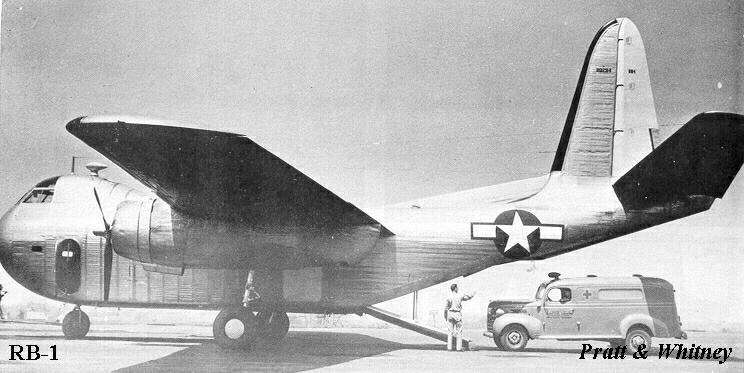

When the U.S. entered World War II in December 1941, there were concerns whether American industry could produce the huge quantity of materials needed to fight the war. One of the main concerns was whether the vast amounts of aluminum needed for aircraft would be available.
The Edward G. Budd Manufacturing Company of Philadelphia, Pennsylvania, the manufacturer of munitions and railroad rolling stock, approached the U.S. Navy (USN) with a proposal to build a twin-engined cargo aircraft comparable to the Douglas R4D, q.v., but made of stainless steel. The USN accepted the proposal and placed an order for 200 RB-1's in August 1942; the U.S. Army Air Forces (USAAF) also became interested and placed an order for 600 aircraft, designated C-93A-BU,
The RB-1 was a twin-engined high-wing monoplane with tricycle landing gear and 24-volt electrical system powered by 1,200 hp (894.8 kW) Pratt & Whitney R-1830-92 14-cylinder, twin-row, air-cooled, radial engines driving three-bladed Hamilton-Standard Hydromatic constant-speed, full-feathering propellers. The rear of the outer portion of the wing, i.e., from the engine nacelle to the wingtip, and the elevators and rudder were fabric covered. The fuselage featured a bulbous nose enclosing an elevated flight deck. The elevated flight deck permitted the cargo area to be unobstructed for its entire length.
The RB-1 was radical for its day but it contained many of the features that are now standard in today's military transports. The flight deck could accommodate three crew members, a pilot and copilot sitting side-by-side and a navigator sitting behind the pilots. Stairs connected the flight deck to the cargo area which was 25 feet (7.62 meters) long with an unobstructed cross-section of 8 x 8 feet (2.44 x 2.44 meters) throughout its length. Cargo loading and unloading could be accomplished in two ways, (1) through 40 x 60 inch (101.6 x 152.4 cm) doors on both sides of the fuselage and/or (2) by an electrically operated 10 x 8 foot (3.05 x 2.44 meter) ramp at the aft end of the cargo area under the upswept tail. The loading ramp, accessed by manually-operated clam-shell doors, along with the tricycle landing gear meant that cargo could be loaded/unloaded at truck-bed height. A manually-operated two ton (1,814 kg) hoist for unloading trucks and a one ton (907 kg) winch for pulling cargo up the ramp were also provided in the cargo area. The aircraft could accommodate (1) 24 paratroopers or (2) 24 stretchers and 16 sitting wounded or (3) 9,600 pounds (4,534 kg) of cargo or (4) a 1-1/2 ton truck or (5) the largest ambulance in use by the U.S. military.
The first flight of the RB-1 occurred on 31 October 1943 and this aircraft was delivered to the USN in March 1944. It crashed during testing and the test pilot swore that the plane's stainless steel construction saved his life. The flying characteristics of the RB-1 were poor and problems with the use of stainless steel developed delaying production and causing the price to rise. These difficulties plus the adequate supply of aluminum and the availability of the C-47/R4D resulted in the USAAF canceling their order for this aircraft and the USN reducing their order from 200 to a total of 26.
OPERATIONAL HISTORY
The RB-1's did not enter squadron service with the USN. Some were assigned to Naval Air Stations (NAS) as "hacks", i.e., utility aircraft, e.g., three were assigned to NAS Patuxent River, Maryland. By 1945, the RB-1's had been transferred to the War Assets Administration (WAA), a government organization tasked with selling war surplus equipment. WAA sold 14 Conestogas to The Flying Tiger Line in July 1945; these were Flying Tiger's first aircraft. Flying Tiger, founded in June 1945, went on to become one of the world's greatest freight airlines.
SPECIFICATIONS
Wing Span: 100 feet (30.48
meters)
Length: 68 feet (20.73 meters)
Height: 31 feet 9 inches
(9.68 meters)
Wing Area: 1,400 square
feet (130.06 square meters)
Empty Weight: 20,156 pounds
(9,143 kg)
Gross Weight: 33,860 pounds
(15,359 kg)
Fuel Capacity 994 U.S. gallons
(3,763 liters)
Maximum Speed: 197 mph at
7,500 feet (317 km/h at 2,286 meters)
Cruising Speed: 165 mph
(265.5 km/h)
Maximum cruising range:
1,620 miles (2,607 km)